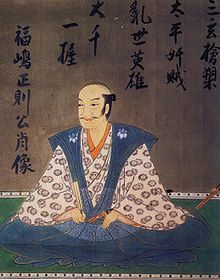Fukushima Masanori
Fukushima Masanori | |
|---|---|
福島 正則 | |
 Fukushima Masanori | |
| Lord of Hiroshima | |
| In office 1600–1619 | |
| Preceded by | Mōri Terumoto |
| Succeeded by | Asano Nagaakira |
| Personal details | |
| Born | Ichimatsu 1561 |
| Died | August 26, 1624 (aged 62–63) |
| Nationality | Japanese |
| Spouse(s) | Omasa |
| Father | Fukushima Masanobu |
| Military service | |
| Allegiance | |
| Unit | |
| Battles/wars | Siege of Miki Battle of Yamazaki Battle of Shizugatake Kyūshū campaign Korean campaign Battle of Gifu Castle Battle of Sekigahara |
Fukushima Masanori (福島 正則, 1561 – August 26, 1624) was a Japanese daimyō of the late Sengoku period to early Edo period who served as lord of the Hiroshima Domain. A retainer of Toyotomi Hideyoshi, he fought in the Battle of Shizugatake in 1583, and soon became known as one of Seven Spears of Shizugatake which also included Katō Kiyomasa and others.
Biography[]


Fukushima Masanori, or as he was first known, Ichimatsu, was born in Owari Province, the son of Fukushima Masanobu. He is believed to have been the cousin of Toyotomi Hideyoshi. He first engaged in battle at the assault on Miki Castle in Harima Province, and following the Battle of Yamazaki, he was granted a 500 koku stipend.
At the Battle of Shizugatake in 1583, he defeated Haigo Gozaemon, a prominent samurai.[1] Masanori (Tenshō 11) had the honor of taking the first head, namely that of the enemy general Ogasato Ieyoshi, receiving a 5000 koku increase in his stipend for this distinction (the other six "Spears" each received 3000 Koku), he married with Omasa.
Masanori took part in many of Hideyoshi's campaigns; it was after the Kyūshū Expedition, however, that he was made a daimyō. Receiving the fief of Imabari in Iyo Province, his income was rated at 110,000 koku. Soon after, he took part in the Korean Campaign. Masanori was to once again receive distinction when he took Ch'ongju.[2]
Following his involvement in the Korean campaign, Masanori was involved in the pursuit of Toyotomi Hidetsugu. He led 10,000 men in 1595, surrounded Seiganji temple on Mount Kōya, and waited until Hidetsugu had committed suicide.[3] With Hidetsugu dead, Masanori received a 90,000 koku increase in stipend, and received Hidetsugu's former fief of Kiyosu, in Owari Province as well.[4]
Battle of Sekigahara[]

In 1600, Masanori sided with Tokugawa Ieyasu 'Eastern army' at the Battle of Sekigahara. He was the leader of the Tokugawa advance guard. He started the battle, and charged north from the Eastern Army's left flank along the Fuji River attacking the Western Army's right centre. Masanori troops fought against Ukita Hideie army, what is said to have been one of the bloodiest confrontations in the battle. Ukita's troops were winning the battle, pushing back Masanori's army. However, after Kobayakawa Hideaki changes side to support Eastern army and his action forced the other armies to had pledged a betrayal. Later, Masanori's army was winning the fight and the Eastern Army won the battle.
After Sekigahara, Masanori ensured the survival of his domain. Although he later lost his holdings, his descendants became hatamoto in the service of the Tokugawa shōgun.
Nihongo spear[]
Nihongo or Nippongo (日本号): A famous spear that was once used in the Imperial Palace. This is one of The Three Great Spears of Japan. Nihongo later found its way into the possession of Fukushima Masanori, and then Tahei Mori. It is now at The Fukuoka City Museum where it was restored.
In popular culture[]
Fukushima Masanori is featured in Koei's video games Kessen, Kessen III, Samurai Warriors, and as a non-playable character in Samurai Warriors 3. He is a playable character in the third installment's expansions, and , and in the fourth installment, Samurai Warriors 4 and its subsequent expansions. He is a playable character in Pokémon Conquest (Pokémon + Nobunaga's Ambition in Japan), with his partner Pokémon being Krokorok and Krookodile.[5]
References[]
- ^ Turnbull, Stephen (1998). The Samurai Sourcebook. London: Cassell & Co. p. 234,240. ISBN 9781854095237.
- ^ Turnbull, Stephen. Samurai Invasion. London: Cassell & Co., p. 120.
- ^ Turnbull, Stephen. Samurai Invasion. London: Cassell & Co., p. 232.
- ^ Berry, Mary Elizabeth. Hideyoshi. Cambridge: Harvard University Press, pp. 127–128.
- ^ "Masanori + Krokorok - Pokémon Conquest characters". Pokémon. Retrieved 2012-06-17.
External links[]
- Biography of Fukushima Masanori (in Japanese)
- 1560 births
- 1624 deaths
- 16th-century Japanese people
- 17th-century Japanese people
- Daimyo
- People from Aichi Prefecture
- Samurai
- Toyotomi retainers